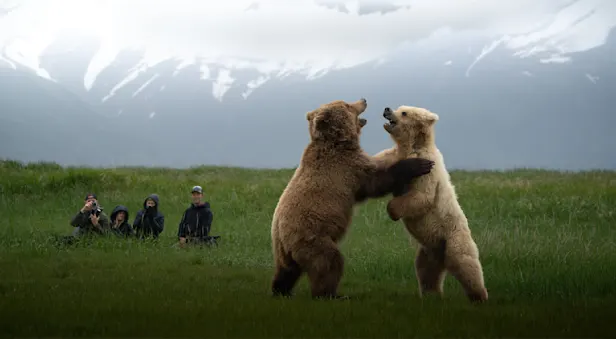Know Before You Go
Bald Eagle Facts | Alaska Wildlife Guide
The bald eagle, our national symbol, is making a spectacular comeback from near-extinction in one of our country’s best-known conservation success stories. Starting with an estimated population of 100,000 in the early 1800s, by the early 1960s there were fewer than 500 known nesting pairs.
In the 1950s and ’60s, scientists figured out that the pervasive use of DDT after World War II as an insect-control measure was causing a thinning of the eggshells of bald eagles and other birds. This, combined with habitat loss, led to the bald eagle being listed as endangered. In 1973, inspired by the influential book Silent Spring by Rachel Carson, legislation passed banning the use of DDT. These two legal moves—listing the eagle as endangered and banning DDT—were the first steps on the road to recovery for the bald eagle.
In 1995 the bald eagle was removed from the endangered list and called a “threatened species” in the lower 48 states. A few years later this magnificent raptor was found secure enough to be removed from the endangered species list altogether.
Physical Characteristics
The adult bald eagle is one of the most-recognized birds in the United States with its distinctive dark body and white head and tail. The term “bald” is not a reflection of their white heads looking bald. It comes from the term “piebald,” which means black and white. To spot these large raptors, look for white “golf balls” in the trees.
Juveniles are less easily identified—they have brown and white plumage and a black bill. Adult plumage develops when the birds reach sexual maturity at 4 or 5 years old. Juveniles are rarely far from the parents, so if you see them, look around for the adults.
Bald eagles are approximately 3 feet tall and have a wingspan that can be more than 6 feet. They weigh 10 to 14 pounds, and southern birds are significantly smaller than their northern relatives. Bald eagles live 15 to 20 years in the wild.
Eagles have incredible eyesight. They can spot a rabbit more than a mile away, see a fish underwater from hundreds of feet in the air, and discern more colors than a human. Each eyeball has two points of focus, so they can see straight ahead and at a 45-degree angle at the same time. Their eyes are so large that they can’t move them within their skulls, so they need to move their heads to look around.
Bald eagles have 7,000 feathers, and they can control each one individually to maintain their body temperature. Because of this insulating coating, eagles do not need to migrate due to cold temperatures. As long as there is a sufficient food supply, they will stay in one area year-round.
Vocals
Don’t believe the movies. Most films that show a bald eagle soaring will use the descending shriek of a red-tailed hawk in the soundtrack. In fact, a bald eagle emits a series of high-pitched whistles that do not sound very fearsome at all.
Feeding Habits
A bald eagle’s preferred food is fish, which is why they are generally found near water. The rich feeding grounds of coastal Alaska and British Columbia host high concentrations of these birds, where they can feed year-round on abundant salmon and other fish. In the central United States, such as the Yellowstone area, they tend to be found along rivers and the shorelines of lakes.
When fish are not available, they don’t hesitate to eat carrion or hunt for small animals like rabbits or muskrats. They will also steal prey from ospreys, which led Benjamin Franklin to call them birds of “bad moral character.”
Eagle Nests
Bald eagles build the largest nests of all North American birds. They use them year after year and continue to build upon the foundation, so a nest that has been in use for many generations might be 8 feet across, 10 feet deep, and weigh 2,000 pounds!
See Bald Eagles on These Alaska Adventures

Grizzly Ship Photo Expedition: Kodiak to Katmai
Based aboard our private small ship, just eight guests photograph brown bears in the roadless Katmai wilderness, going ashore with an expert bear naturalist and photography pro who knows these animals intimately.

























